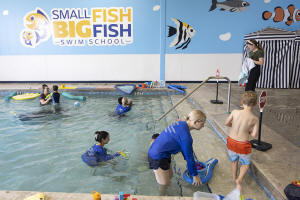For kids with autism, swim classes can be lifesaving
[May 21, 2025]
By JENNIFER PELTZ
WEST PALM BEACH, Fla. (AP) — In an airy indoor pool with fish cutouts on
the walls, a group of small children bobbed, floated and tentatively
flutter-kicked.
It was what it looked like, a starter swimming class. But here,
instructors worked one-on-one or even two to a child. Some held cards to
help kids communicate with teachers by pointing instead of speaking. No
one blew whistles.
All the students in the class at the Small Fish Big Fish swim school had
autism, a developmental disorder linked to a higher-than-average danger
of drowning.
It has long worried autism experts and parents, but recent data make the
stakes starkly clear. In Florida, a state where water abounds from
beaches to backyards, over 100 children who had autism or were being
evaluated for it have drowned since the start of 2021, according to the
Children’s Services Council of Palm Beach County.
The numbers highlight an oft-overlooked dilemma: Autism makes swimming
instruction all the more necessary but, often, all the more difficult to
get.
“It’s life-changing for kids with autism,” said Lovely Chrisostome, who
was terrified this winter when her 6-year-old son slipped out of the
family’s home and wandered through their lake-dotted neighborhood. She’d
once tried enrolling him in swim classes at a public pool, but he had
refused to go in.
But her son was in the pool at the autism-specific class at Small Fish
Big Fish. An instructor helped him float on his back. When he started
showing discomfort – he doesn’t like to get his head wet – she eased him
onto his side, where he seemed content.
Autism affects an estimated 1 in 31 U.S. children. Their water safety
has gotten occasional public attention after tragedies such as the death
of Avonte Oquendo, an autistic teen who was found in a New York river in
2014 after disappearing from his school.

While academic research on the issue is limited, a pair of 2017 studies
documented a substantially heightened risk of drowning among people with
autism spectrum disorder. The risk stems in large part from their
propensity to wander off and to underappreciate perils, according to
co-author Dr. Guohua Li and other experts.
One Florida 5-year-old apparently wriggled out a doggy door and got into
his grandmother’s pool. Another died in a canal after slipping through a
fence hole at a playground specifically intended for autistic kids. A
6-year-old drowned in a lake after she evidently climbed a bookshelf
positioned to block an apartment door, according to the Children’s
Services Council of Palm Beach County. It’s now building a national
database.
“Swimming lessons should be a first-line treatment for autism,” said Li,
a Columbia University epidemiology professor who isn't involved in the
council's research. Li himself has a son with the condition.
Lessons a potential lifesaver
Some autistic people excel at swimming, such as the New Jersey teens
featured in the 2017 documentary “Swim Team." Many others are adept in
water. Even some profoundly autistic children can master survival basics
with as little as eight hours of aquatic occupational therapy, said
Michele Alaniz, a practitioner who published research based on her work
at Casa Colina Hospital and Centers for Healthcare in Pomona,
California.
But some families don't sign up for classes, fearing they'll overwhelm
children who might have symptoms ranging from not speaking to repeatedly
banging their heads to becoming distressed by noise. Other youngsters
get kicked out of programs that can’t handle them. Private sessions can
be helpful, but pricey.
[to top of second column]
|

In this handout photo provided by Children's Services Council of
Palm Beach County, swim instructors work with students during an
autism-specific swim class at Small Fish Big Fish, Tuesday, April 1,
2025 in West Palm Beach, Fla. (Ben Rusnak /Children's Services
Council of Palm Beach County via AP)

“Having somebody that understands a child on the spectrum — what the
special needs are, how to communicate with a child, how to also mitigate
a meltdown, particularly in a pool — is so vital,” says Lindsey Corey.
She said her 5-year-old son didn't absorb much from a general swim class
or from private lessons at home in Lake Worth, Florida, but made
progress in a program with instructors trained by the Autism Society.
As drowning risks have come into focus, advocates are trying to make
swimming lessons more accessible. An Australian charity called Autism
Swim says 1,400 swim teachers, physical therapists and others worldwide
have taken its online training since 2016.
Trepidation and joy in the water
In Florida, the Children's Services Council's of Palm Beach County
provided $17,000 last year for the Autism Society of America to train
dozens of instructors, said Jon Burstein, who did the council's research
on autism and drowning. The organization paid another $13,500 for the
classes at Small Fish Big Fish.
The dozen students, ranging from about 4 to 8, attend a nearby
autism-specific charter school. They initially were reluctant to get in
the bus, let alone in the water, organizers said. But on an early April
afternoon, they readily headed for the shallow pool.
One girl floated on a foam board with her face in the water, an exercise
in breath control. Another girl grinned as she propelled herself on a
foam noodle.
“She's fearless to the point it's scary because she'll just jump into a
pool, whether she can swim or not,” her mother, Jana D'Agostino, said
later. “So this is really important. It's saving their lives.”
Across the pool, a boy reluctantly eased himself from the steps into the
water, where Small Fish founder Melissa Taylor waited for him. “My
turn!” she said, and dunked her head in the water.
He did likewise, then retreated to the steps. Taylor continued working
with him, but he soon backed out of the pool and began making hand
movements. Realizing he'd had enough, instructors let him towel off.

“It's taking a lot to get him to trust us,” explained Taylor. But she
also recognizes when repetitive splashing and movement signal
excitement, not alarm.
The session continued for the other children, including Chrisostome's
son, who emerged with a smile.
He has learned a lot in the lessons, but what struck her most?
“The happiness that he has."
All contents © copyright 2025 Associated Press. All rights reserved |